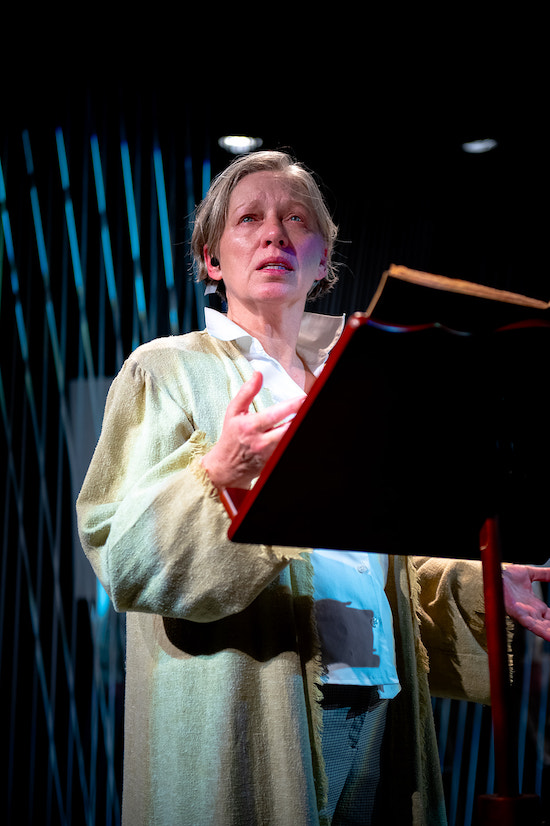IN Series revives intriguing but flawed theatrical retooling of Verdi “Requiem”

Nanna Ingvarsson is Verdi/Lear in The Promised End, presented by IN Series at the Source Theatre. Photo: Bayou Elom
As an opera director Timothy Nelson has often retooled classic works in a way that can bring new meanings. He has continued in that vein since becoming artistic director of the IN Series in 2018.
This year Nelson has revived such a work from his inaugural season, The Promised End, as part of Washington’s Shakespeare Everywhere Festival, seen Wednesday night at Source Theatre.
Given the title Viva V.E.R.D.I. at its premiere, the work is an unclassifiable mash-up of Giuseppe Verdi’s epic Missa Da Requiem with Shakespeare’s King Lear, which Verdi long dreamed of adapting as an opera. In brief introductory remarks, Nelson explained the action: as Verdi’s funeral cortege bears his body from Milan to his place of burial in 1901, the composer’s ghost dreams of the version of Lear he might have created.
This explication was crucial, since most of the text spoken by the actress Nanna Ingvarsson, reprising the role of Verdi/Lear from the premiere, was lost in the musical maelstrom. In quiet moments or during pauses in Verdi’s often-thunderous score, one could pick out bits of the Shakespeare play, mixed with Nelson’s speculative text, adapted partially from an essay by Marjorie Garber. Even though Ingvarsson was amplified and the musicians were not, most of the spoken part was simply inscrutable.
The idea, in other words, was more intriguing than the execution. Verdi’s score is inherently more operatic than liturgical: even when performed in concert it calls out for staging. Nelson has resized the work for the black box theater at Source, with eight singers belting out the massive choral sections and dividing up the four solo parts among them, accompanied only by piano. Even with these reduced forces, the musical sound often overwhelmed, especially with conductor Emily Baltzer hurling all of her force at the lidless piano, even smashing the keyboard in violent clusters.
The work began with Ingvarsson’s Verdi hearing her own funeral. The eight singers, hidden in the wings, sang the chorus “Va, pensiero” from the composer’s Nabucco, as the crowds did as they followed Verdi’s body. She introduced the octet of singers as memories of the characters from Verdi’s most celebrated operas. They were costumed in ghostly white versions of 19th-century outfits as Violetta, Rigoletto and Gilda, Falstaff and so on (costume design by Maria Bissex).
While the hushed Introit section provided a dramatic opening, again with the singers off stage at times, Nelson aligned the bombastic opening movement of the Dies Irae with the storm scene in King Lear. The lighting, complete with flashes of lightning for the storm, helped change the mood from hopeful to bleak (designed by Marianne Meadows). Verdi repeats this stormy section of music several times throughout the work, which worked well in this new version.
The ensemble singing was quite strong overall, with enough force to give the sense of a larger chorus. Individual performances sometimes fell short. Kudos to countertenor Hunter Shaner for stepping in for an indisposed colleague: while his timbre was unsuitable for Verdi’s style, he mostly had the notes for the part. Henrique Carvalho, while an imposing bass presence, did not quite have the bottom notes in the Confutatis section.
Verdi did turn to the texture of unaccompanied voices several times in the work, and these moments worked best in the new context. The singers moved fluidly from a platform and area at the rear of the stage through the set, consisting of cords strung between the ceiling and floor at various angles, creating abstract shapes. Much was made of a wreath placed on Verdi’s head and then moved among the singers before it was eventually returned to the composer.
The most touching moment came at the end, with the ethereal conclusion of the Libera Me movement. Soprano Maribeth Diggle sang much of this solo part, seeming like a mixture of Lear’s beloved daughter Cordelia and Verdi’s adopted daughter Maria. The latter was present at the composer’s bedside when he died, along with soprano Teresa Stolz, who sang the soprano solo in the Missa Da Requiem at its 1874 premiere. The other soprano, Teresa Ferrara, took over the middle part of this solo, including the perilous high B-flats, which she sang ably.
Nelson made much of connecting a line from Lear’s final speech (“Pray you, undo this button”) to Verdi’s last words (“one button more, one button less”), spoken to a maid as he was dressing himself in a hotel bedroom before he suffered a fatal stroke. While the Dies Irae, the funeral prayer, lacked the gleaming apocalyptic trumpets Verdi gave it, rendered simply on the piano by Baltzer, singers banged on a bass drum positioned on stage at the work’s most famous measures from the Dies Irae.
The Promised End runs through December 17, with some changes in cast and venue. inseries.org
